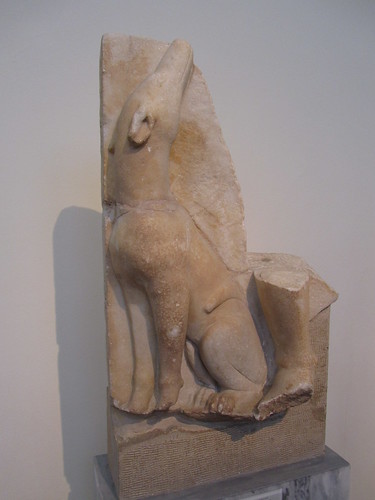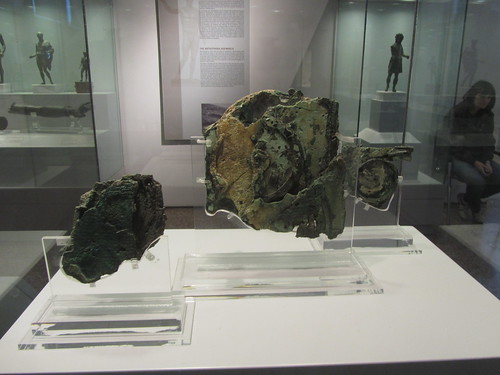As I work to get back on track, I'm starting by working on labeling the many still unlabeled pictures that I've got on Flickr. Right now, I'm tackling one of the bigger sets, those that I took at the National Archaeological Museum of Athens. Last fall, I visited Greece and Turkey, and it was fantastic, and I took a ton of pictures, but I still haven't gotten most of them labeled. I took about 800 total at the National Archaeological Museum of Athens, which was the most spectacular assemblage of ancient Greek art that I've ever seen. Now, that includes all the labels, so it's really closer to 400 - 500 pics. I've only labeled about 50 of them so far, so as I proceed through the labeling, I'll post some more that I particularly like or found interesting. (normally, I'd wait til I'd done the whole set before doing a post like this, but I'm determined to get back on track posting in the blog, so sacrifices must be made... :) )
The marbles are definitely the highlight of the museum. They have thousands, and many are very, very fine, from throughout Greek history.
This is a Kore.

Kore are a traditional type of female sculpture from the ancient Greek empire. This one is the most beautiful I've ever seen. Some of the pigment is still left on her chiton, and the detail work is spectacular. When I see a work like this, I wonder how ancient sculptures must have looked when they were fresh and new and hadn't been buried, weathered, and otherwise damaged by the past two millennia.
This is the base of a funerary sculpture, showing four people betting on the fight between a dog and a cat.

The details are just breath taking. I think that dog is in trouble...
Speaking of dogs...

I just like this one.
The most interesting thing I've already labeled are the shot I took of the remains of the Antikythera device.

The
Antikythera Device is one of the amazing remains of the ancient world. Found in a ship wreck off the island of Antikythera, it's taken a century of research to figure out just what it might be. As far as we can tell, this complex construct of gears and bits and pieces was a mechanical astronomical clock, which used the movements of the moon and stars to tell the time. Workmanship of it's like doesn't appear again for 1500 years. It was made in the 1st century BC.
The one I most wanted to share on this blog is this one...

Not as remarkable as the others, but take a closer look! That lady, sitting on he left, is holding a spindle in her hand! Yes, she's a spinner! This gravestone dates to the 5th century BC, but some things really haven't changed that much. :)
That's all for now!
 Kore are a traditional type of female sculpture from the ancient Greek empire. This one is the most beautiful I've ever seen. Some of the pigment is still left on her chiton, and the detail work is spectacular. When I see a work like this, I wonder how ancient sculptures must have looked when they were fresh and new and hadn't been buried, weathered, and otherwise damaged by the past two millennia.
This is the base of a funerary sculpture, showing four people betting on the fight between a dog and a cat.
Kore are a traditional type of female sculpture from the ancient Greek empire. This one is the most beautiful I've ever seen. Some of the pigment is still left on her chiton, and the detail work is spectacular. When I see a work like this, I wonder how ancient sculptures must have looked when they were fresh and new and hadn't been buried, weathered, and otherwise damaged by the past two millennia.
This is the base of a funerary sculpture, showing four people betting on the fight between a dog and a cat.
 The details are just breath taking. I think that dog is in trouble...
Speaking of dogs...
The details are just breath taking. I think that dog is in trouble...
Speaking of dogs...
 I just like this one.
The most interesting thing I've already labeled are the shot I took of the remains of the Antikythera device.
I just like this one.
The most interesting thing I've already labeled are the shot I took of the remains of the Antikythera device.
 The Antikythera Device is one of the amazing remains of the ancient world. Found in a ship wreck off the island of Antikythera, it's taken a century of research to figure out just what it might be. As far as we can tell, this complex construct of gears and bits and pieces was a mechanical astronomical clock, which used the movements of the moon and stars to tell the time. Workmanship of it's like doesn't appear again for 1500 years. It was made in the 1st century BC.
The one I most wanted to share on this blog is this one...
The Antikythera Device is one of the amazing remains of the ancient world. Found in a ship wreck off the island of Antikythera, it's taken a century of research to figure out just what it might be. As far as we can tell, this complex construct of gears and bits and pieces was a mechanical astronomical clock, which used the movements of the moon and stars to tell the time. Workmanship of it's like doesn't appear again for 1500 years. It was made in the 1st century BC.
The one I most wanted to share on this blog is this one...
 Not as remarkable as the others, but take a closer look! That lady, sitting on he left, is holding a spindle in her hand! Yes, she's a spinner! This gravestone dates to the 5th century BC, but some things really haven't changed that much. :)
That's all for now!
Not as remarkable as the others, but take a closer look! That lady, sitting on he left, is holding a spindle in her hand! Yes, she's a spinner! This gravestone dates to the 5th century BC, but some things really haven't changed that much. :)
That's all for now!
No comments:
Post a Comment